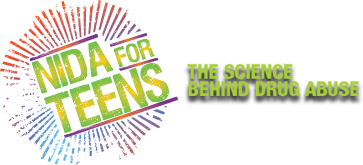Help Teens Make Smart Decisions
The more you know about prescription drug abuse (and the science behind it), the more you'll want to help your friends (if you're a teenager) or students (if you're an educator) learn the facts and make smart decisions. NIDA developed the tools on this Web site to help you get the word out and make a positive difference in teens' lives.
The Facts and Activity Guide for students and teachers will support you in your efforts. Downloadable posters, buddy icons, and more Downloads will make it fun to help teens avoid prescription drug abuse.
Background
Prescription drug abuse is a big problem among youth across the Nation. Among youth who are 12 to 17 years old, 2.8 percent reported past-month nonmedical use of prescription medications (that is, without a doctor’s guidance). In fact, according to the 2012 Monitoring the Future Survey, prescription and over-the-counter medications are among the most commonly abused drugs by 12th graders, after alcohol, marijuana, and tobacco. When asked how prescription narcotics (opioids) were obtained for nonmedical use, more than half of the 12th graders surveyed said they were given the drugs or bought them from a friend or relative.
The Problem
Teens are making the decision to abuse prescription medicines based on misinformation. Teens abuse prescription drugs for a number of reasons, including to get high, to treat pain, and because they think it will help them with school work. Teens often don't realize prescription drugs can have dangerous short- and long-term health consequences when used inappropriately (e.g., using someone else's medication or taking their own medication in a way other than prescribed, such as a larger dose or more frequently). In addition, teens may not know that using prescription medications that are not prescribed to the user is illegal.
A New Initiative
The National Institute on Drug Abuse (NIDA) is reaching out to help stop this troubling problem among teens. "Prescription drug abuse is not new, but it does deserve continued vigilance," said NIDA Director Nora D. Volkow, M.D. "It is imperative that as a Nation we make ourselves aware of the consequences associated with the abuse of these medications." Whether you are an educator, mentor, or student, NIDA encourages you to use materials provided by PEERx to learn about prescription drug abuse and to spread the word about its effects on health.
About PEERx
PEERx was created to provide educators, mentors, student leaders, and teens with science-based information about the harmful effects that prescription drug abuse has on the brain and body. Information sharing is a collective effort; therefore, NIDA is asking you to take the information provided on this Web site and raise awareness among teens in your community about the dangers and effects of abusing prescription drugs.
Many features of this site can be used to help generate ideas on how to raise awareness among the teens you encounter daily. Learn the science behind prescription drug abuse in The Facts. Get helpful tips for teachers and student leaders on how to engage teens actively through homework assignments or extracurricular projects in the Activity Guide. Use fun downloads for teens to help spread the word among friends and classmates in Downloads. Check out the latest Sara Bellum Blog posts and leave a comment on the Blog.
Make your mark on this topic today! Inform your community. Introduce yourself to PEERx.
References
- National Institute on Drug Abuse. NIDA Research Report: Prescription Drugs: Abuse and Addiction(http://www.drugabuse.gov/ResearchReports/Prescription/Prescription.html). NIH Publication No. 11-4881. Bethesda, MD: NIDA, NIH, DHHS. Published July 2001. Revised October 2011. Retrieved December 2012.
- National Institute on Drug Abuse. Monitoring the Future. Data Tables and Figures (http://monitoringthefuture.org/data/12data/pr12t2.pdf and http://monitoringthefuture.org/data/12data/pr12t6.pdf). Bethesda, MD: NIDA, NIH, DHHS. December 2012. Retrieved December 2012.





